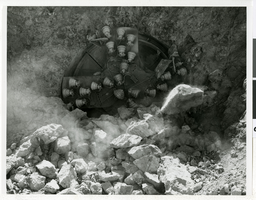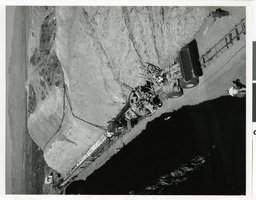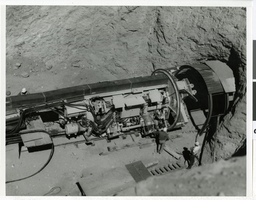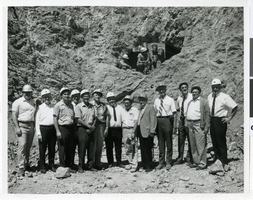Search the Special Collections and Archives Portal
Search Results
Maryellen Vallier Sadovich Papers
Identifier
Abstract
The Maryellen Vallier Sadovich Papers include transcripts and handwritten and photocopied documents pertaining to early Nevada history from 1852 to 1934. Documents include information about the boundaries of Nevada; mail service contracts between Utah and California; documents from the Department of the Interior, Office of Indian Affairs concerning reservations in Southern Nevada; a copy of Gibb's Phonetic alphabet of Southern Nevada Native American languages; maps of tributaries in Southern Nevada; notes about the National Archives photographic holdings of Nevada; and documents from mining reports.
Archival Collection
T. David Horton Photographs of Pioche, Nevada
Identifier
Abstract
The T. David Horton Photographs of Pioche, Nevada contain black-and-white photographs of several buildings in Pioche, Nevada in the 1960s. The collection contains photographs of the Pioche Power and Light Company, Pioche’s mine, crushing plant, cemetery, and oversize photographs of the town.
Archival Collection
John R. Bruckman Photographs of Nellis Air Force Base
Identifier
Abstract
The John R. Bruckman Photographs of Nellis Air Force Base contain photographs of Nellis Air Force Base near Las Vegas, Nevada from 1951 to 1954. The collection includes photographs of the Nellis Air Force Base Baseball Team, base headquarters, buildings on the base, and soldiers outside of the Last Frontier Hotel in Las Vegas.
Archival Collection
Kathy Augustine Papers
Identifier
Abstract
The Kathy Augustine Papers date from 1977 to 1997 and are comprised of the documents of Augustine's political career as an Assemblywoman and State Senator in Nevada. The collection includes political correspondence relating to State Senate Bills (SB) and Assembly Bills (AB), material from Augustine's Assembly campaign, and newsletters from Desert Express, Sage, and Sagehen. The collection also includes other correspondence related to Augustine's time in office, and social events.
Archival Collection
Arlene Mathews Smith Photograph Collection
Identifier
Abstract
The Arlene Mathews Smith Photograph Collection (1910-1945) is comprised of photographs of people and places in and around Panaca, Nevada. The collection contains a photograph album featuring Smith, her family and friends, and various residents and events around the area. Included as part of the collection are photographs from the Last Frontier Hotel in Las Vegas, Nevada.
Archival Collection
Las Vegas PRIDE Parade Records
Identifier
Abstract
The Las Vegas PRIDE Parade Records (2016-2017) contain administrative files that document how the Southern Nevada Association of PRIDE, Inc. (SNAPI) organized the 2016 and 2017 PRIDE parades in Las Vegas, Nevada. Materials include correspondence with event organizers, parade participant information, and PRIDE event guides.
Archival Collection

Photograph of the "Mole" Jarva Tunnel Borer breaking through the tunnel on the Las Vegas River Mountain Project, Las Vegas, Nevada, circa 1968-1971
Date
Archival Collection
Description
Image

Photograph of the 988 caterpillar loader towing mole and conveyor to the tunnel portal used on the Las Vegas River Mountain Project, Las Vegas, Nevada, circa 1968-1971
Date
Archival Collection
Description
Image

Photograph of the outlet portal showing the mole preparing to walk into the tunnel on the Las Vegas River Mountain Project, Las Vegas, Nevada, circa 1968-1971
Date
Archival Collection
Description
Image

Photograph of Key federal, state and contractor representatives who were on hand when the mole broke through the tunnel, Las Vegas, Nevada, 6-26-69
Date
Archival Collection
Description
Image
